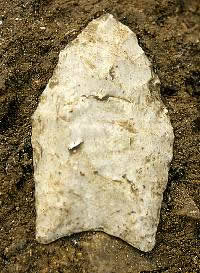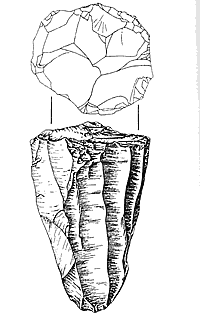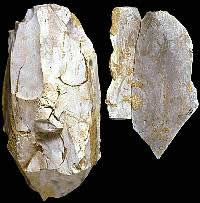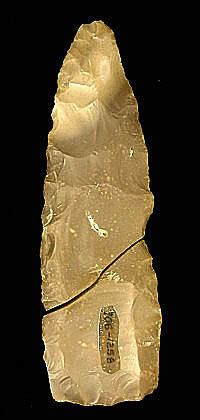Clovis First?
By 13,500 years ago (11,500 B.C.), bands of people were roaming the hills and rugged chasms of the Plateaus and Canyonlands region. Based on current evidence, the earliest of these groups belonged to the Clovis culture, known for its distinctive tools and toolmaking techniques. Traditionally these early folk have been characterized as “mobile big-game hunters” exploring and colonizing a pristine, unoccupied continent as they chased Ice-Age megafauna, such as mammoth and bison. Evidence from Kincaid Shelter on the southern edge of the Edward Plateau in Uvalde County, however, suggests that some Clovis groups were more diversified and place-bound than previously thought. There, Clovis families invested the time and labor to carefully construct a stone pavement to cover the muddy shelter floor—presumably because they stayed for a while and exploited a wide variety of smaller animals, plants, and other local resources, such as tool-making stone (flint/chert).
A similarly broad subsistence pattern has been detected at the Gault site in Bell county, just northeast of the Edwards Plateau. Other Clovis sites in the region include Wilson-Leonard and Pavo Real. At Pavo Real, Clovis knappers refurbished their tool kits and weapons, leaving behind toolmaking debris characteristic of Clovis blade technology. This highly specialized approach to stone-tool making resulted in distinctive cast-off debris: rejected blades, exhausted blade cores, and blade core “tablets” which had been struck off the ends of cores to rejuvenate them and extend their usefulness.
Was Clovis really North America’s first culture? Taken together, the Clovis evidence from this region and elsewhere in North America is now seen by some experts as reflecting the lives of peoples who were already quite familiar with the landscape. Several sites in the region, including Wilson-Leonard and Bonfire Shelter, have tantalizing but inconclusive evidence of earlier occupational traces underlying and thus pre-dating Clovis layers. The distinct possibility that earlier Pre-Clovis cultures existed in North America is attracting scholarly (and public) attention, rival claims, and heated controversy. At present, however, there is no definitive evidence that any humans lived in the Plateaus and Canyonlands prior to Clovis peoples.



